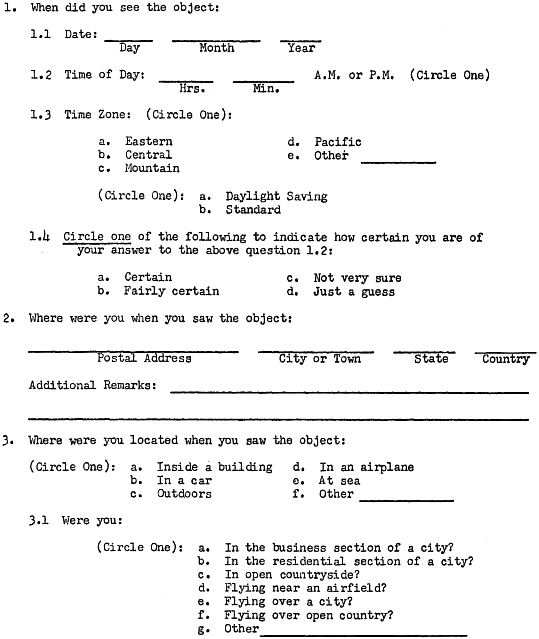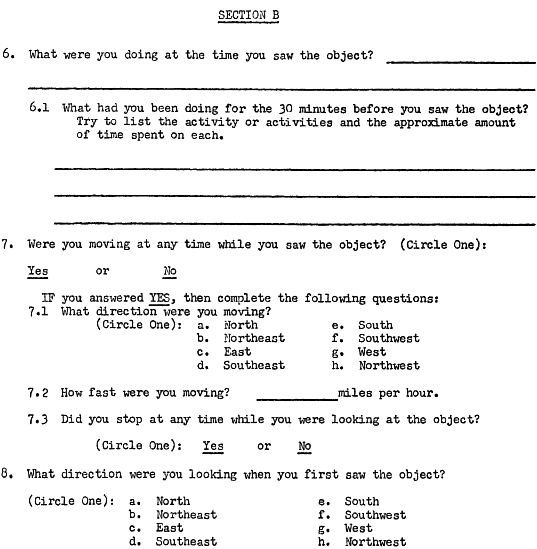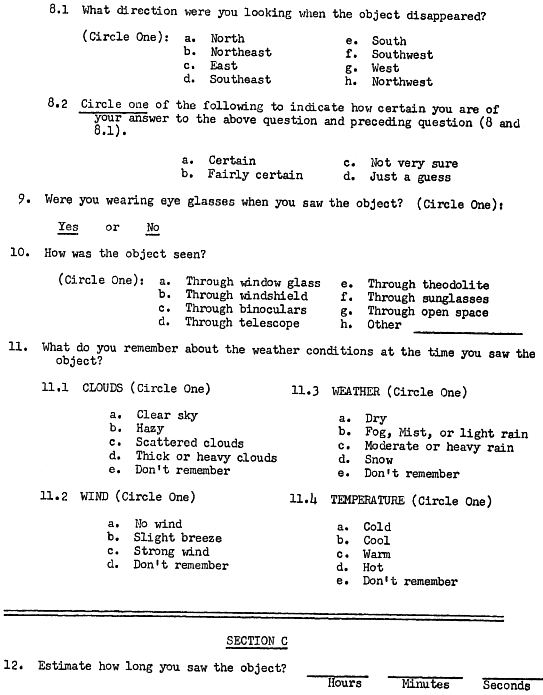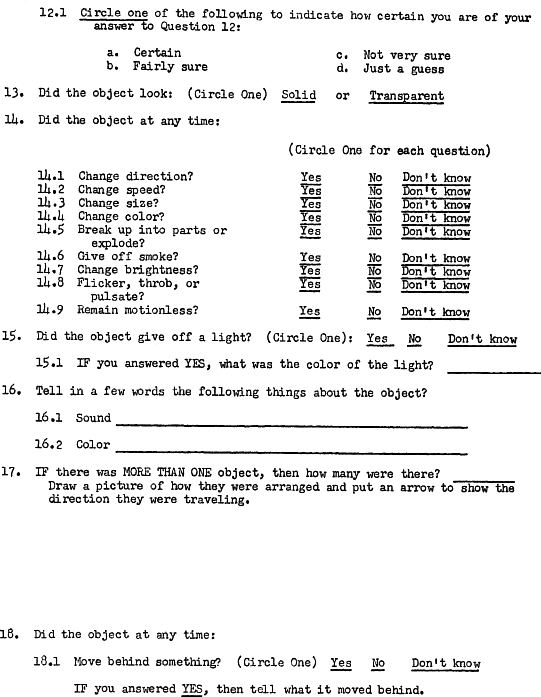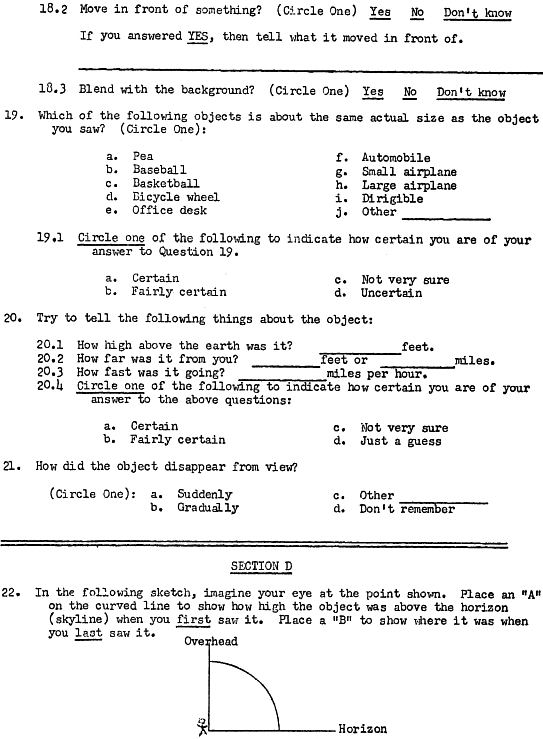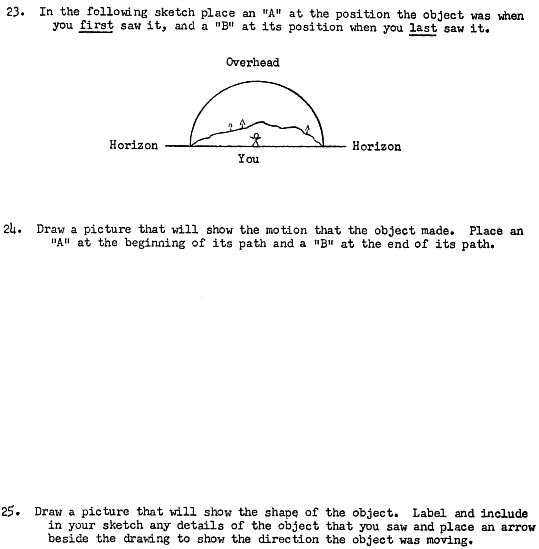|
[ RESTRICTED ] -16- for a meteor. The two lights were white and moved in a parallel direction. It is recommended that an Observer's Questionnaire be sent to this observer, as his sighting bears a resemblance to the sighting made by Astronomer R. It was impossible to obtain full details of these sightings because this would have classed me as an official investigator. The details of these sightings should be obtained by official questionnaires. A meteorologist at the Lowell Observatory is identified here as observer PP. He was not interviewed, but a clipping was obtained from a Flagstaff newspaper covering his observations made on May 27, 1950. The object was observed between 12:15 and 12:20 p.m. on Saturday, May 20, from the grounds of the Lowell Observatory. The object presented a bright visible disc to the naked eye and passed moderately rapidly in front of a fractocumulus cloud in the northwest. Upon passing in front of the cloud its appearance changed from that of a bright object to a dark object, due to the change in contrast. No engine noise was heard, nor was there any exhaust. It seems that this might have been a weather balloon but in this case it would be strange if this meteorologist would become confused by it. He reports that it was not moving with the wind, but across the wind. Finally, in this survey or astronomers, my associates and I at the Perkins Observatory should be included. There are six of us there, and to the best of my knowledge, none of us has ever seen any unexplainable object in the skies. While in Albuquerque, I met, through Dr. La Paz, a Dr. Everton Conger, Instructor in Journalism at the University of New Mexico. On July 27, 1948, [ RESTRICTED
] UNCLASSIFIED ================================================================ [ RESTRICTED ] -17- between 8:35 and 8:45 a.m. he noticed a disc-shaped object in the sky. It was flat and round like a flat plate. It appeared to be made of duraluminum and gave off reflected light very similar to the light reflected from a highly polished airplane wing. The full details of his sighting are in my notes. I obtained his cooperation and he would be very glad to fill out an official questionnaire. I also interviewed, while in Albuquerque, Mr. Redman and Mr. Morris, the two gentlemen whose picture appeared in Life magazine in the now-famous article on flying saucers. I questioned them separately and found that their stories were remarkably consistent. Indeed, since they viewed the object from widely different parts of the city, there is some possibility that the parallax of the object can be obtained by making theodolite sightings now on where the object appeared to them. The position of the object can be identified now because it was viewed close to a canyon in the mountains, Dr. La Paz has kindly offered to obtain the parallax of this object for us. SUMMARY AND DISCUSSION Over 40 astronomers were interviewed of which five had made sightings of one sort or another. This is a higher percentage than among the populace at large. Perhaps this is to be expected, since astronomers do, after all, watch the skies. On the other hand, they will not likely be fooled by balloons, aircraft, and similar objects, as may the general populace. [ RESTRICTED
] UNCLASSIFIED ================================================================ [ RESTRICTED ] -18- It is interesting to remark upon the attitude of the astronomers interviewed. The great majority were neither hostile nor overly interested; they gave one the general feeling that all flying saucer reports could be explained as misrepresentations of well-known objects and that there was nothing intrinsic in the situation to cause concern. I took the time to talk rather seriously with a few of them, and to acquaint them with the fact that some of the sightings were truly puzzling and not at all easily explainable. Their interest was almost immediately aroused, indicating that their general lethargy is due to lack of information on the subject. And certainly another contributing factor to their desire not to talk about these things is their overwhelming fear of publicity. One headline in the national papers to the effect that "Astronomer Sees Flying Saucer" would be enough to brand the astronomer as questionable among his colleagues. Since I was able to talk with the men in confidence, I was able to gather very much more of their inner thoughts on the subject than a reporter or an interrogator would have been able to do. Actual hostility is rare; concern with their own immediate scientific problems is too great. There seems to be no convenient method by which to attack this problem, and most astronomers do not wish to become involved, not only because of the danger of publicity but because the data seem tenuous and unreliable. Therefore, it is my considered recommendation that the following procedure be adopted by the Air Force: First, the problem of unidentified aerial objects should be given the status of a scientific problem. In any scientific problem, the data are gathered with meticulous care and are weighed and considered, without rush, by [ RESTRICTED
] UNCLASSIFIED ================================================================ [ RESTRICTED ] UNCLASSIFIED entirely competent men. Therefore, it is proposed that some reputable group of scientists be asked to examine recent sightings which have already gone through one or two screenings. If this group becomes convinced that the data are worthy of being treated as a scientific problem, that is, that the sightings are valid and that unexplained phenomena really do exist, then they should be asked to vouch that these data are "worthy of being admitted into court". Armed with this scientific opinion, various scientific societies should be approached. The American Physical Society, the American Astronomical Society, and the Optical Society of America are suggested, in particular. These Societies should be asked, in view of the validity of the data, to appoint one or more members to constitute a panel to advise ATIC and perhaps to direct the necessary researches into the phenomena. This would serve not only to work toward an ultimate solution of the problem, but in the meantime would lend dignity to the project. In short, either the phenomena which have been observed are worthy of scientific attention or they are not. If they are, then the entire problem should be treated scientifically and without fanfare. It is presumed that the scientific panel would work with the full knowledge and cooperation of the general contractor, but would not be bound by secrecy, which would tend to hamper their work. It is possible that this panel might be a panel in the RDB, similar to those in geodesy, infrared, or upper atmospheric research. In the meantime, it is recommended that the Air Force approach the Joint Chiefs of Staff for endorsement of a considered statement of philosophy and policy for presentation to the public press, There is much confusion in [ RESTRICTED ] ================================================================ [ RESTRICTED ] UNCLASSIFIED the public mind as to what is being done about the situation, add a great deal of needless criticism is being directed toward the Air Forces for "trying to cover up!" or "dismissing the whole thing". The considered statement to the public press that the problem is being considered as a scientific one and is being referred to competent scientists in various fields should do a very great deal in satisfying the public clamour. It may be, of course, that this proposal will not get beyond the first step. The scientist, or scientists, who examine the carefully screened evidence may decide there still is not enough evidence to admit the problem into the court of scientific appeal. Personally, I hardly think that this will be the case, since the number of truly puzzling incidents is now impressive. The second stage may be a long one. The first effort should be to determine with great accuracy what the phenomena to be explained really are and to establish their reality beyond all question. Third stage would be the eventual publication of the findings of the scientific panel. This might take the form of a progress report. If, for instance, the scientific chase is led into a detailed examination of atmospheric optics, one can envision, perhaps, many years of work. This however, is the price one pays for a truly scientific investigation. One final item is that the flying-saucer sightings have not died down, as was confidently predicted some years ago when the first deluge of sightings was regarded as mass hysteria. Unless the problem is attacked scientifically, we can look forward to periodic recurrences or flying-saucer reports. It appears, indeed, that the flying saucer along with the automobile is here to stay, and if we can't shoo it away, we must try to understand it. [ RESTRICTED ] ================================================================ [ RESTRICTED ] UNCLASSIFIED APPENDIX While in Los Angeles, I was asked to appear in a TV program with Gerald Herd, the BBC science analyst; with Walter Riddel, the rocket expert; and with Aldous Huxley. They were to have a round-table discussion on flying saucers. I declined immediately but was prevailed upon to be in the studio when the program was in progress. I am afraid that my presence as an astronomer "cramped their style" to a great degree, but nonetheless the program had the general effect of convincing the hearers that flying saucers did exist. There was very little constructive about the program. It consisted of a rehash of all the things we have heard so much about already. It might be profitable, for instance, to have a TV program, sponsored by the Air Force, acquainting the public with the problem of flying saucers as a scientific problem. Though suggested jokingly, there might be some point to this, if this investigation ever gets to the scientific panel stage. JAH:eg [ RESTRICTED ] ================================================================ [ RESTRICTED ]
This document consists of 5 pages
FIFTH STATUS REPORT on CONTRACT AF-19741, PPS-100 to AIR TECHNICAL INTELLIGENCE CENTER September 10, 1952
UNCLASSIFIED [ RESTRICTED
] T52-12138 ================================================================ [ RESTRICTED ]
TABLE OF CONTENTS
UNCLASSIFIED [ RESTRICTED
] T52-12138 ================================================================ [ RESTRICTED ] FIFTH STATUS REPORT on CONTRACT AF-19741, PPS-100 to AIR TECHNICAL INTELLIGENCE CENTER September 10, 1952 This report describes progress on this project for the period from August 11, 1952, to September 10, 1952. Interrogation Forms About 800 copies of the revised Tentative Observers Questionnaire, Exhibit A of the Fourth Status Report, dated August 11, 1952, were prepared and sent to ATIC. A great many of these were sent out by ATIC to observers to be filled out and returned. That was considered a "trial test" of the questionnaire. More than 100 of the completed questionnaires have been returned to us. These are now being studied by Dr. Paul M. Fitts and his associates in the Aviation Psychology Department at Ohio State University. The final revisions of the questionnaire will be made as results of this study show that revisions are needed. The Final Observers Questionnaire is expected to be completed and sent to ATIC during September. [ RESTRICTED
] T52-12138 ================================================================ [ RESTRICTED ] -2- Analysis of Existing Sighting Reports Work has continued on the coding of sighting reports to make possible an analysis by IBM machines. The reports for 1947, 1948, 1949, and 1951 are nearly completed. Considerable time was spent during August in conferences at which final evaluations were made on sightings for these years. These final evaluations were needed to put into the IBM system for use in future analysis. The final evaluation conference was conducted by ATIC and our personnel. It is believed that this method or evaluation of sightings is adding greatly to the over-all analysis. It is, however, taking additional time. It had previously been estimated that all of the backlog of files could be coded and placed in the IBM system by September 15, 1952. However, during the past few months, sighting reports have been accumulating at an unprecedented rate. In fact, the up-to-date 1952 file now contains nearly as many sightings as all previous years together. Therefore, the task of coding and analyzing the file has approximately doubled during recent months. For this reason, considerably more time will be needed to put the sighting reports on a current basis and to complete the analysis. Some of the IBM cards are now being prepared and preliminary analyses are being started. Newspaper Clipping Service As requested by ATIC, an order has been issued to discontinue this service on October 1, 1952. UNCLASSIFIED [ RESTRICTED
] T52-12138 ================================================================ [ RESTRICTED ] -3- Future Work The coding of sighting reports will be continued and analyses will be started using the IBM system. A Final Observers Questionnaire will be completed in September. Special attention will be given to certain sightings by the panel of consultants, as is found necessary in the final evaluation conferences. PJR:eg
UNCLASSIFIED [ RESTRICTED
] T52-12138 ================================================================ [ RESTRICTED ]
This document consists of 5 pages
SIXTH STATUS REPORT on CONTRACT AF-19741, PPS-100 to AIR TECHNICAL INTELLIGENCE CENTER October 10, 1952
UNCLASSIFIED [ RESTRICTED
] T52-12141 ================================================================ [ RESTRICTED
]
TABLE OF CONTENTS
T52-12141 ================================================================ [ RESTRICTED ]
SIXTH STATUS REPORT on CONTRACT AF-19741, PPS-100 to AIR TECHNICAL INTELLIGENCE CENTER October 10, 1952
This report describes progress for the period from September 11, 1952, to October 10, 1952. ANALYSIS OF EXISTING SIGHTING REPORTS Work has continued on the coding of sighting reports to permit analysis by IBM machines. Reports up to and including 1951 are completed except for final evaluation of about 40 per cent of them. It is anticipated that final evaluation of all reports of sightings previous to 1952 will be completed during the month of October, in conference with ATIC personnel. Therefore, by the end of October all sighting reports for the years 1947, 1948, 1949, 1950, and 1951 will be ready as a group for preliminary analysis on IBM equipment. Sighting reports for the first four months of 1952 were received late in September. Coding of these early 1952 reports was begun and should be completed, except for final evaluation, by October 20. Because the quality and quantity of information in many of the 1952 sighting reports has improved, T52-12141 ================================================================ [ RESTRICTED ] -2- and in many cases more than one sighting is included in the folder, more time was required for coding these reports than for earlier ones. Because sighting reports accumulated at a rapid rate in May, June, and July, 1952, and in general were more detailed than earlier reports, it is estimated that it will require until the latter part of November, 1952, to complete processing and evaluation of these reports for IBM analysis. MISCELLANEOUS SPECIAL ASSIGNMENTS The panel of consultants was utilized during the month to advantage on the following topics: Analysis of Film Two rolls of 35-mm spectrographic film and a section of gun-camera spectrographic film, furnished by the Air Force for analysis, were examined by experts on spectroscopy. After examination of the film, it was found impractical to proceed further with the analysis without more data. Although would be possible by indirect methods to arrive at limited conclusions regarding the sources of light that were photographed. The expense would be prohibitive. Further data needed for analysis of film should be derived from controlled experiments using known sources of light, and from information on the following factors: 1. Type of camera 2. Shutter speed UNCLASSIFIED [ RESTRICTED ]
T52-12141 ================================================================ [ RESTRICTED ] -3- 3. Aperture opening 4. Range 5. Type of grid used and details of grid construction 6. Type of film used Simple standards could be established by which it should be possible to determine the source of light photographed with the camera and spectrographic equipment, at relatively little expense. It is believed that the camera and equipment will be most useful when the light is emitted by a single chemical element. If two or more elements are involved, analysis will be difficult with this simple recording device. Soil and Vegetation Samples During the month, two sets of soil and vegetation samples were studied by an agricultural specialist and by physicists. Regarding the "Florida" samples, no difference was observed between the two samples of soil, but it was found that the root structure of the plants from the area in question was degenerated, apparently by heat, while the root structure of a control sample was undisturbed. In addition, the lower leaves, those nearest the ground under normal conditions, were slightly deteriorated, apparently by heat. No logical explanation is possible for this alteration of the first sample, beyond the suggestion that a high soil temperature around the plants could have been the cause. No radioactivity was found in any of these samples. UNCLASSIFIED [ RESTRICTED ]
T52-12141 ================================================================ [ RESTRICTED ] -4- Regarding the "Kansas" samples, no difference was found between either the soil or the vegetation from the two areas from which the specimens were obtained. These samples are now being examined for radioactivity. Consultant on Astronomy Advice and assistance from Dr. J. Allen Hynek was received during the month concerning astronomical objects mistaken as "flying saucers". A few fundamental rules which had been given before were further elaborated. Dr. Hynek also gave ten consulting hours to the task of improving the questions in the latest revised questionnaire. INTERROGATION FORMS During July, August, and September, Dr. Paul M. Fitts and associates of the Aviation Psychology Department of Ohio State University have served as consultants on the preparation of a questionnaire that would permit the United States Air Force to obtain a maximum of useful information from those persons who report sightings or unidentified aerial objects. Insofar as possible, the following criteria were used in designing the questionnaire: 1. To
develop questions which could transfer from the observer to the U. S.
Air Force as
UNCLASSIFIED [ RESTRICTED ]
T52-12141 ================================================================ [ RESTRICTED ] -5- 2. To
develop questions that would permit some evaluation of the accuracy and
reliability of 3. To develop questions that could be:
(a) easily understood by a majority of the public, To meet the first criterion adequately, some questions were taken from the first "Tentative Observer's Data Sheet". Suggestions and advice from Dr. J. Allen Hynek, Professor of Astronomy, Ohio State University, were requested and used, and other questions, believed to be important and useful, were devised. A copy of the second draft of the "Tentative Observer's Data Sheet" is included as Exhibit I of this report. In general, most or the questions in the second draft seem to fall in one of the following informational categories: 1. When
the event occurred, and where the observer was located at the time of
the sighting, The second draft or the "Tentative Observer's Data Sheet" was designed for a trial test for selecting and improving questions for the final questionnaire. Over 300 of these questionnaires were sent to observers by ATIC. Replies to 168 of them were analyzed. On the basis of this analysis, a UNCLASSIFIED [ RESTRICTED ]
T52-12141 ================================================================ [ RESTRICTED ] -6- summary of these replies is included in Exhibit I of this report. A new questionnaire, the "U. S. Air Force Technical Information Sheet" has been designed, in which several questions were omitted, some were revised, and others added. As an example, it was found that many observers were unable to reply to the question which asked for an estimation of the "real" size of the object. This question was restated in the form of an "apparent" size. A sample of the "U. S. Air Force Technical Information Sheet", is given as exhibit II of this report, Form A is for specific data, and Form B is for a short verbal summary expressed in the observer's own words. Multiple-choice questions, completion questions, and drawings are used throughout the final questionnaire so as to get as accurate a description as possible. The multiple-choice question is well adapted for use in large-scale statistical studies. The second criterion used in preparing the questionnaire is most difficult to achieve. As far as possible, questions were worded to provide a check on the consistency and competence of the observer. The best check of consistency would be to have the observer answer the questionnaire twice with an interval of time separating the two replies. Since this is not practical, it was decided that the next best way would be to have the observer fill in an objective multiple-choice section and, in addition, write out a summary description in a summary data sheet. Any obvious discrepancies between information given in this description and that given in the questionnaire would make the observer's replies questionable. An evaluation of the observer's personality traits and mental competence is likewise difficult to achieve in such a questionnaire. In addition UNCLASSIFIED [ RESTRICTED ]
T52-12141 ================================================================ [ RESTRICTED ] -7- to the low validity of standardized questionnaires specifically designed to test these aspects of the individual, the restriction exists that the observer should not detect that his competence is being considered. In spite of the limitations, it was decided to include several questions which might operate indirectly to reveal any severely abnormal factors. Two questions (No. 24 and No. 38) were inserted for the specific purpose of detecting replies of the fanatic and over-imaginative individual. A reasonable assumption is that the person who uses fantastic explanations and descriptions, and who appears to be convinced that the sighting was produced by unknown creatures or interplanetary visitors, is not likely to be a discerning observer, It is further proposed that such individuals will be prone to fabricate details, and suffer severe memory distortions when recounting the event. Questions Nos. 5.1 and 22.1 are intended to indicate the over-anxious respondent. With the exception of a few instances in which accurate measurements may be made, normally one would not expect an observer to be "certain" that he had seen an object for a specific time or of a specific apparent size. Again, these types of data can be subjected to controlled experimentation in which observers make estimates of duration and of size, together with certainty ratings. Question No. 26 is an important question if No. 36.1 receives a negative reply, and if the duration of the sighting were of sufficient length that one could reasonably expect other observers also to see the object. If this is the case, then one would suspect that the sighting was a result of individual factors. An effort was made to satisfy the third criterion for the questionnaire by using simple language and non-technical terminology. It is recognized that UNCLASSIFIED [ RESTRICTED ]
T52-12141 ================================================================ [ RESTRICTED ] -8- this requirement would not permit many trained observers (scientists, pilots, etc.) to present important technical data, therefore it is recommended that a different questionnaire be used or that different channels be employed for communicating with this select group of individuals. Whenever possible, the questions were written in multiple-choice form, so that they could be easily answered and accurately recorded, If it appeared that too many categories would be needed to cover all possible responses, or if the categories would lead to doubtful or erroneous interpretation, then the question was worded so that the observer could fill in his own answer. A large number of the questions permit the observer to give a "Don't Know" or a "Don't Remember" response, and thus do not force a guess or an incorrect answer. It was decided that the observer should be asked to circle the correct answer to the multiple-choice items, thereby allowing minimum ambiguity in the instructions and maximum objective scoring. Systems such as checking or under- lining the correct answer are often misinterpreted by the respondent because of previous experience with various ambiguous checking and "X-ing" systems, such as voting procedures. It is anticipated that when a sufficient sample of replies has been received from the second questionnaire that further minor revisions will appear necessary. FUTURE WORK One-thousand copies of the "U. S. Air Force Technical Information Sheet" (Form A and Form B) will be printed and made available to ATIC in the near future.
T52-12141 ================================================================ [ RESTRICTED ] -9- Results of tests for radiation on the "Kansas" soil and vegetation sample will be completed. The coding and evaluation of 1952 sighting reports will continue, and analysis of these reports will be started using the IBM system. Final evaluation, in conference with ATIC personnel, will be completed on all remaining unevaluated sighting reports dated before 1952. PJR/VWE:eg
T52-12141 ================================================================ [ RESTRICTED ]
EXHIBIT I. TENTATIVE OBSERVER'S QUESTIONNAIRE.
[ RESTRICTED
] UNCLASSIFIED ================================================================ [ RESTRICTED ]
TENTATIVE OBSERVERS QUESTIONNAIRE
================================================================ SECTION A
[ RESTRICTED ]
UNCLASSIFIED ================================================================
[ RESTRICTED ]
UNCLASSIFIED 4. How did you happen to notice the object?
___________________________________
5. When did you report to some official that you had seen the object? ___________ _________________ __________ ================================================================
[ RESTRICTED ]
UNCLASSIFIED ================================================================
[ RESTRICTED ]
UNCLASSIFIED
[ RESTRICTED ]
UNCLASSIFIED ================================================================
[ RESTRICTED ]
UNCLASSIFIED
[ RESTRICTED ]
UNCLASSIFIED ================================================================
[ RESTRICTED ]
[ RESTRICTED ]
UNCLASSIFIED ================================================================
[ RESTRICTED ]
----------------------------------------------------------------------------
[ RESTRICTED ] ================================================================
[ RESTRICTED ] Page 7
UNCLASSIFIED ================================================================
[ RESTRICTED ] Page 8
30. Please add here any further comments which you believe are
important.
UNCLASSIFIED ================================================================
|
